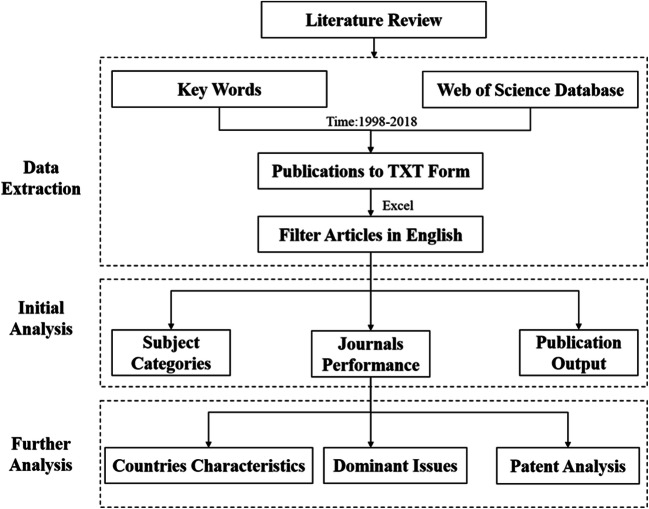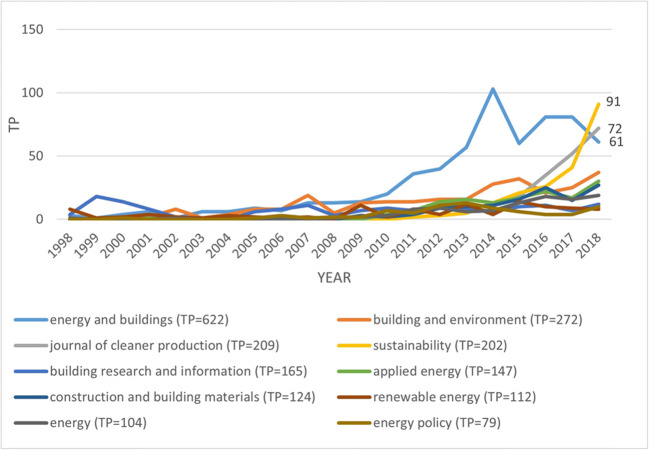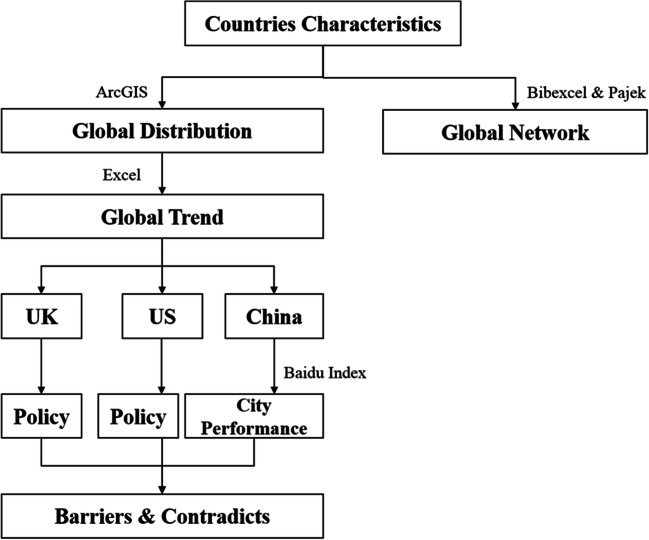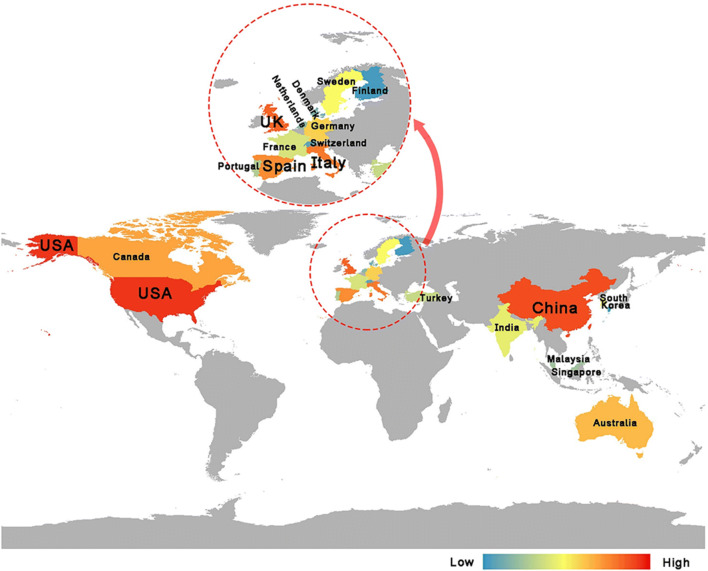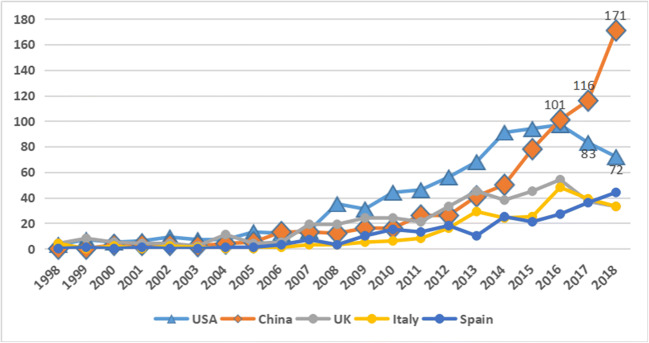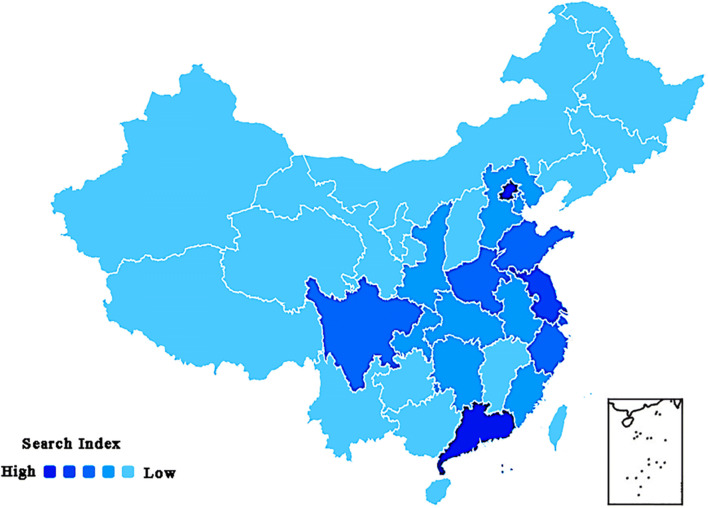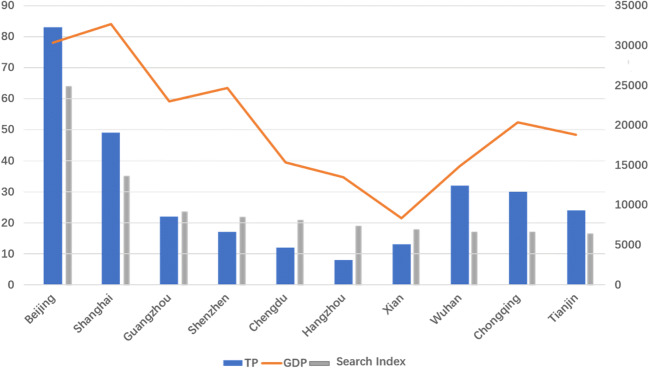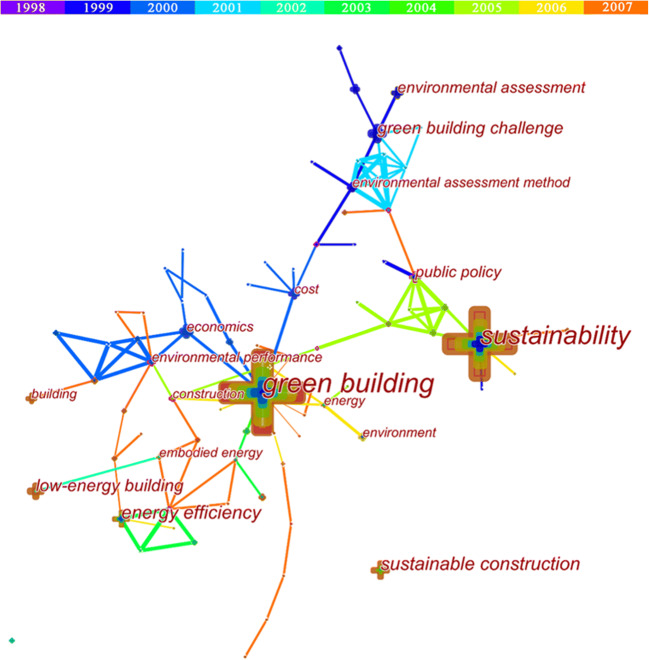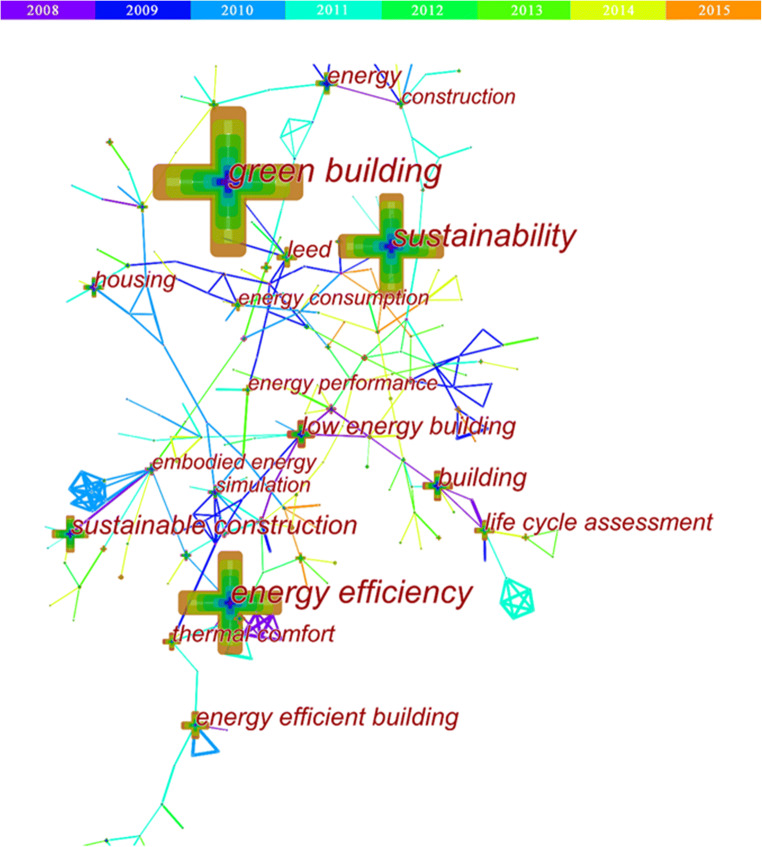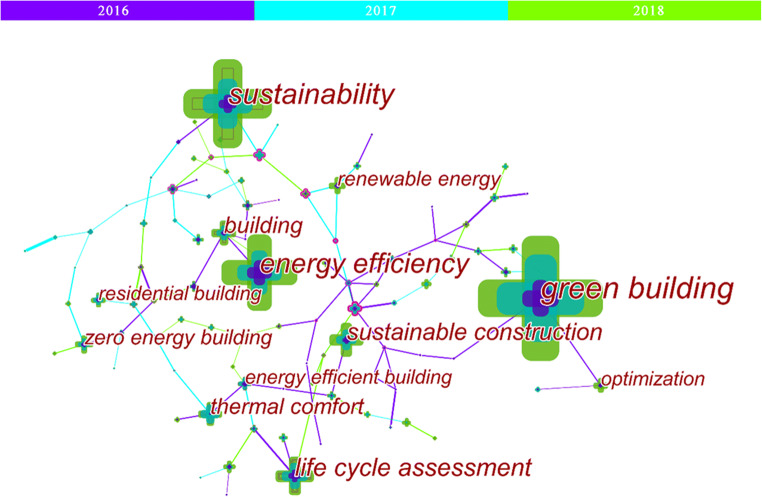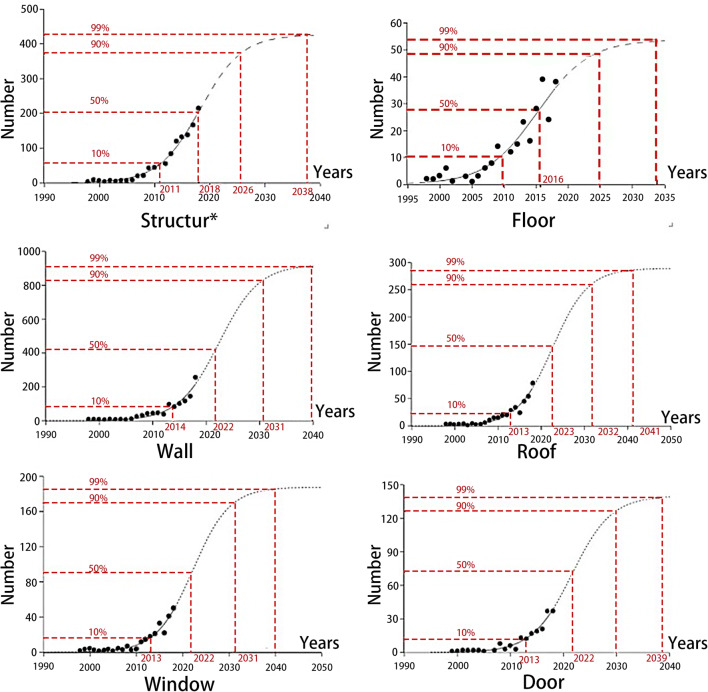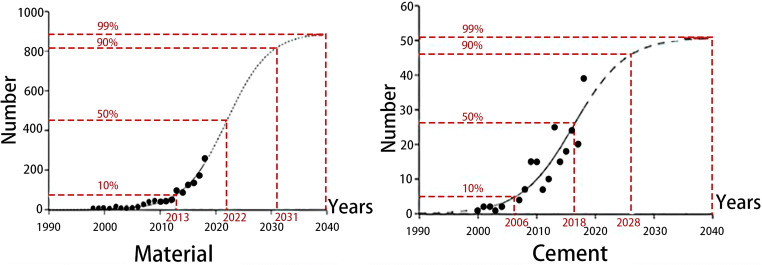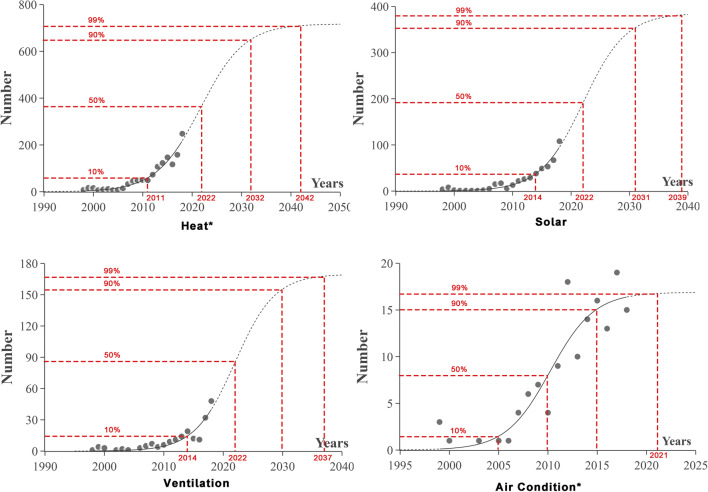Abstract
Buildings account for nearly 2/5ths of global energy expenditure. Due to this figure, the 90s witnessed the rise of green buildings (GBs) that were designed with the purpose of lowering the demand for energy, water, and materials resources while enhancing environmental protection efforts and human well-being over time. This paper examines recent studies and technologies related to the design, construction, and overall operation of GBs and determines potential future research directions in this area of study. This global review of green building development in the last two decades is conducted through bibliometric analysis on the Web of Science, via the Science Citation Index and Social Sciences Citation Index databases. Publication performance, countries’ characteristics, and identification of key areas of green building development and popular technologies were conducted via social network analysis, big data method, and S-curve predictions. A total of 5246 articles were evaluated on the basis of subject categories, journals’ performance, general publication outputs, and other publication characteristics. Further analysis was made on dominant issues through keyword co-occurrence, green building technologies by patent analysis, and S-curve predictions. The USA, China, and the UK are ranked the top three countries where the majority of publications come from. Australia and China had the closest relationship in the global network cooperation. Global trends of the top 5 countries showed different country characteristics. China had a steady and consistent growth in green building publications each year. The total publications on different cities had a high correlation with cities’ GDP by Baidu Search Index. Also, barriers and contradictions such as cost, occupant comfort, and energy consumption were discussed in developed and developing countries. Green buildings, sustainability, and energy efficiency were the top three hotspots identified through the whole research period by the cluster analysis. Additionally, green building energy technologies, including building structures, materials, and energy systems, were the most prevalent technologies of interest determined by the Derwent Innovations Index prediction analysis. This review reveals hotspots and emerging trends in green building research and development and suggests routes for future research. Bibliometric analysis, combined with other useful tools, can quantitatively measure research activities from the past and present, thus bridging the historical gap and predicting the future of green building development.
Supplementary Information
The online version contains supplementary material available at 10.1007/s11356-021-12739-7.
Keywords: Green buildings, Bibliometric analysis, Big data, Cite space, Patent analysis, S-curve, Energy efficiency
Introduction
Rapid urban development has resulted in buildings becoming a massive consumer of energy (Yuan et al. 2013), liable for 39% of global energy expenditure and 68% of total electricity consumption in the USA (building). In recent years, green buildings (GBs) have become an alternative solution, rousing widespread attention. Also referred to as sustainable buildings, low energy buildings, and eco-buildings, GBs are designed to reduce the strain on environmental resources as well as curb negative effects on human health by efficiently using natural resources, reducing garbage, and ensuring the residents’ well-being through improved living conditions (Agency USEP Indoor Air Quality; Building, n.d). As a strategy to improve the sustainability of the construction industry, GBs have been widely recognized by governments globally, as a necessary step towards a sustainable construction industry (Shen et al. 2017).
Zuo and Zhao (2014) reviewed the current research status and future development direction of GBs, focusing on connotation and research scope, the benefit-difference between GBs and traditional buildings, and various ways to achieve green building development. Zhao et al. (2019) presented a bibliometric report of studies on GBs between 2000 and 2016, identifying hot research topics and knowledge gaps. The verification of the true performance of sustainable buildings, the application of ICT, health and safety hazards in the development of green projects, and the corporate social responsibility were detected as future agenda. A scientometrics review of research papers on GB sources from 14 architectural journals between 1992 and 2018 was also presented (Wuni et al. 2019a). The study reported that 44% of the world participated in research focusing on green building implementation; stakeholder management; attitude assessment; regulations and policies; energy efficiency assessment; sustainability performance assessment; green building certification, etc.
With the transmission of the COVID-19 virus, society is now aware of the importance of healthy buildings. In fact, in the past 20 years, the relationship between the built environment and health has aroused increasing research interest in the field of building science. Public spaces and dispersion of buildings in mixed-use neighborhoods are promoted. Furthermore, telecommuting has become a trend since the COVID-19 pandemic, making indoor air quality even more important in buildings, now (Fezi 2020).
The system for evaluating the sustainability of buildings has been established for nearly two decades. But, systems dedicated to identifying whether buildings are healthy have only recently appeared (McArthur and Powell 2020). People are paying more and more attention to health factors in the built environment. This is reflected in the substantial increase in related academic papers and the increase in health building certification systems such as WELE and Fitwel (McArthur and Powell 2020).
Taking the above into consideration, the aim of this study is to examine the stages of development of GBs worldwide and find the barriers and the hotpots in global trends. This study may be beneficial to foreign governments interested in promoting green building and research in their own nations.
Methodology
Overall description of research design
Since it is difficult to investigate historical data and predict global trends of GBs, literature research was conducted to analyze their development. The number of published reports on a topic in a particular country may influence the level of industrial development in that certain area (Zhang et al. 2017). The bibliometric analysis allows for a quantitative assessment of the development and advancement of research related to GBs and where they are from. Furthermore, it has been shown that useful data has been gathered through bibliometrics and patent analysis (Daim et al. 2006).
In this report, the bibliometric method, social network analysis (SNA), CiteSpace, big data method, patent analysis, and S-curve analysis are used to assess data.
Methods
Bibliometrics analysis
Bibliometrics, a class of scientometrics, is a tool developed in 1969 for library and information science. It has since been adopted by other fields of study that require a quantitative assessment of academic articles to determine trends and predict future research scenarios by compiling output and type of publication, title, keyword, author, institution, and countries data (Ho 2008; Li et al. 2017).
Social network analysis
Social network analysis (SNA) is applied to studies by modeling network maps using mathematics and statistics (Mclinden 2013; Ye et al. 2013). In the SNA, nodes represent social actors, while connections between actors stand for their relationships (Zhang et al. 2017). Correlations between two actors are determined by their distance from each other. There is a variety of software for the visualization of SNA such as Gephi, Vosviewer, and Pajek. In this research, “Pajek” was used to model the sequence of and relationships between the objects in the map (Du et al. 2015).
CiteSpace
CiteSpace is an open-source Java application that maps and analyzes trends in publication statistics gathered from the ISI-Thomson Reuters Scientific database and produces graphic representations of this data (Chen 2006; Li et al. 2017). Among its many functions, it can determine critical moments in the evolution of research in a particular field, find patterns and hotspots, locate areas of rapid growth, and breakdown the network into categorized clusters (Chen 2006).
Big data method
The big data method, with its 3V characters (volume, velocity, and variety), can give useful and accurate information. Enormous amounts of data, which could not be collected or computed manually through conventional methods, can now be collected through public data website. Based on large databases and machine learning, the big data method can be used to design, operate, and evaluate energy efficiency and other index combined with other technologies (Mehmood et al. 2019). The primary benefit of big data is that the data is gathered from entire populations as opposed to a small sample of people (Chen et al. 2018; Ho 2008). It has been widely used in many research areas. In this research, we use the “Baidu Index” to form a general idea of the trends in specific areas based on user interests. The popularity of the keywords could imply the user’s behavior, user’s demand, user’s portrait, etc. Thus, we can analyze the products or events to help with developing strategies. However, it must be noted that although big data can quantitatively represent human behavior, it cannot determine what motivates it. With the convergence of big data and technology, there are unprecedented applications in the field of green building for the improved indoor living environment and controlled energy consumption (Marinakis 2020).
Patent analysis
Bibliometrics, combined with patent analysis, bridges gaps that may exist in historical data when predicting future technologies (Daim et al. 2006). It is a trusted form of technical analysis as it is supported by abundant sources and commercial awareness of patents (Guozhu et al. 2018; Yoon and Park 2004). Therefore, we used patent analysis from the Derwent patent database to conduct an initial analysis and forecast GB technologies.
S-curve
There are a variety of methods to predict the future development prospects of a technology. Since many technologies are developed in accordance with the S-curve trend, researchers use the S-curve to observe and predict the future trend of technologies (Bengisu and Nekhili 2006; Du et al. 2019; Liu and Wang 2010). The evolution of technical systems generally goes through four stages: emerging, growth, maturity, and decay (saturation) (Ernst 1997). We use the logistics model (performed in Loglet Lab 4 software developed by Rockefeller University) to simulate the S-curve of GB-related patents to predict its future development space.
Data collection
The Web of Science (WOS) core collection database is made up of trustworthy and highly ranked journals. It is considered the leading data portal for publications in many fields (Pouris and Pouris 2011). Furthermore, the WOS has been cited as the main data source in many recent bibliometric reviews on buildings (Li et al. 2017).
Access to all publications used in this paper was attained through the Science Citation Index-Expanded and the Social Sciences Citation Index databases. Because there is no relevant data in WOS before 1998, our examination focuses on 1998 to 2018. With consideration of synonyms, we set a series of green building-related words (see Appendix) in titles, abstracts, and keywords for bibliometric analysis. For example, sustainable, low energy, zero energy, and low carbon can be substituted for green; housing, construction, and architecture can be a substitute for building (Zuo and Zhao 2014).
Analytical procedure
The study was conducted in three stages; data extraction was the first step where all the GB-related words were screened in WOS. Afterwards, some initial analysis was done to get a complete idea of GB research. Then, we made a further analysis on countries’ characteristics, dominant issues, and detected technology hotspots via patent analysis (Fig. 1).
Fig. 1.
Analytical procedure of the article
Results and analysis
General results
Of the 6140 publications searched in the database, 88.67% were articles, followed by reviews (6.80%), papers (3.72%), and others (such as editorial materials, news, book reviews). Most articles were written in English (96.78%), followed by German (1.77%), Spanish (0.91%), and other European languages. Therefore, we will only make a further analysis of the types of articles in English publications.
The subject categories and their distribution
The SCI-E and SSCI database determined 155 subjects from the pool of 5246 articles reviewed, such as building technology, energy and fuels, civil engineering, environmental, material science, and thermodynamics, which suggests green building is a cross-disciplinary area of research. The top 3 research areas of green buildings are Construction & Building Technology (36.98%), Energy & Fuels (30.39%), and Engineering Civil (29.49%), which account for over half of the total categories.
The journals’ performance
The top 10 journals contained 38.8% of the 5246 publications, and the distribution of their publications is shown in Fig. 2. Impact factors qualitatively indicate the standard of journals, the research papers they publish, and researchers associated with those papers (Huibin et al. 2015). Below, we used 2017 impact factors in Journal Citation Reports (JCR) to determine the journal standards.
Fig. 2.
The performance of top10 most productive journals
Publications on green building have appeared in a variety of titles, including energy, building, environment, materials, sustainability, indoor built environment, and thermal engineering. Energy and Buildings, with its impact factor 4.457, was the most productive journal apparently from 2009 to 2017. Sustainability (IF = 2.075) and Journal of Cleaner Production (IF = 5.651) rose to significance rapidly since 2015 and ranked top two journals in 2018.
Publication output
The total publication trends from 1998 to 2018 are shown in Fig. 3, which shows a staggering increase across the 10 years. Since there was no relevant data before 1998, the starting year is 1998. Before 2004, the number of articles published per year fluctuated. The increasing rate reached 75% and 68% in 2004 and 2007, respectively, which are distinguished in Fig. 3 that leads us to believe that there are internal forces at work, such as appropriate policy creation and enforcement by concerned governments. There was a constant and steady growth in publications after 2007 in the worldwide view.
Fig. 3.
The number of articles published yearly, between 1998 and 2018
The characteristics of the countries
Global distribution and global network were analyzed to illustrate countries’ characteristics. Many tools such as ArcGIS, Bibexcel, Pajek, and Baidu index were used in this part (Fig. 4).
Fig. 4.
Analysis procedure of countries’ characteristics
Global distribution of publications
By extracting the authors’ addresses (Mao et al. 2015), the number of publications from each place was shown in Fig. 5 and Table 1. Apparently, the USA was the most productive country accounting for 14.98% of all the publications. China (including Hong Kong and Taiwan) and the UK followed next by 13.29% and 8.27% separately. European countries such as Italy, Spain, and Germany also did a lot of work on green building development.
Fig. 5.
Global geographical distribution of the top 20 publications based on authors’ locations
Table 1.
Global geographical distribution of the top 20 publications based on authors’ locations
| NO. | Place | TP |
|---|---|---|
| 1 | USA | 786 |
| 2 | China | 445 |
| 3 | UK | 434 |
| 4 | Italy | 249 |
| 5 | Spain | 223 |
| 6 | Canada | 200 |
| 7 | Germany | 186 |
| 8 | Australia | 186 |
| 9 | South Korea | 167 |
| 10 | Hong Kong | 151 |
| 11 | India | 122 |
| 12 | Sweden | 121 |
| 13 | France | 107 |
| 14 | Taiwan | 101 |
| 15 | Turkey | 91 |
| 16 | Netherlands | 80 |
| 17 | Portugal | 79 |
| 18 | Malaysia | 79 |
| 19 | Denmark | 71 |
| 20 | Singapore | 70 |
Global research network
Global networks illustrate cooperation between countries through the analysis of social networks. Academic partnerships among the 10 most productive countries are shown in Fig. 6. Collaboration is determined by the affiliation of the co-authors, and if a publication is a collaborative research, all countries or institutions will benefit from it (Bozeman et al. 2013). Every node denotes a country and their size indicates the amount of publications from that country. The lines linking the nodes denote relationships between countries and their thickness indicates the level of collaboration (Mao et al. 2015).
Fig. 6.
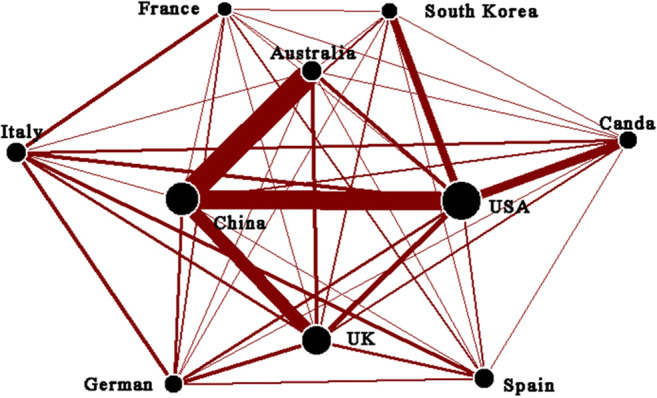
The top 10 most productive countries had close academic collaborative relationships
It was obvious that China and Australia had the strongest linking strength. Secondly, China and the USA, China, and the UK also had close cooperation with each other. Then, the USA with Canada and South Korea followed. The results indicated that cooperation in green building research was worldwide. At the same time, such partnerships could help countries increase individual productivity.
Global trend of publications
The time-trend analysis of academic inputs to green building from the most active countries is shown in Fig. 7.
Fig 7.
The publication trends of the top five countriesbetween 1998 and 2018 countries areshown in Fig 7.
Before 2007, these countries showed little growth per year. However, they have had a different, growing trend since 2007. The USA had the greatest proportion of publications from 2007, which rose obviously each year, reaching its peak in 2016 then declined. The number of articles from China was at 13 in 2007, close to the USA. Afterwards, there was a steady growth in China. Not until 2013 did China have a quick rise from 41 publications to 171 in 2018. The UK and Italy had a similar growth trend before 2016 but declined in the last 2 years.
Further analysis on China, the USA, and the UK
Green building development in China
Policy implementation in China
Green building design started in China with the primary goal of energy conservation. In September 2004, the award of “national green building innovation” of the Ministry of Construction was launched, which kicked off the substantive development of GB in China. As we can see from Fig. 7, there were few publications before 2004 in China. In 2004, there were only 4 publications on GB.
The Ministry of Construction, along with the Ministry of Science and Technology, in 2005, published “The Technical Guidelines for Green Buildings,” proposing the development of GBs (Zhang et al. 2018). In June 2006, China had implemented the first “Evaluation Standard for Green Building” (GB/T 50378-2006), which promoted the study of the green building field. In 2007, the demonstration of “100 projects of green building and 100 projects of low-energy building” was launched. In August 2007, the Ministry of Construction issued the “Green Building Assessment Technical Regulations (try out)” and the “Green Building Evaluation Management,” following Beijing, Tianjin, Chongqing, and Shanghai, more than 20 provinces and cities issued the local green building standards, which promoted GBs in large areas in China.
At the beginning of 2013, the State Council issued the “Green Building Action Plan,” so the governments at all levels continuously issued incentive policies for the development of green buildings (Ye et al. 2015). The number of certified green buildings has shown a blowout growth trend throughout the country, which implied that China had arrived at a new chapter of development.
In August 2016, the Evaluation Standard for Green Renovation of Existing Buildings was released, encouraging the rise of residential GB research. Retrofitting an existing building is often more cost-effective than building a new facility. Designing significant renovations and alterations to existing buildings, including sustainability measures, will reduce operating costs and environmental impacts and improve the building’s adaptability, durability, and resilience.
At the same time, a number of green ecological urban areas have emerged (Zhang et al. 2018). For instance, the Sino-Singapore Tianjin eco-city is a major collaborative project between the two governments. Located in the north of Tianjin Binhai New Area, the eco-city is characterized by salinization of land, lack of freshwater, and serious pollution, which can highlight the importance of eco-city construction. The construction of eco-cities has changed the way cities develop and has provided a demonstration of similar areas.
China has many emerging areas and old centers, so erecting new, energy efficiency buildings and refurbishing existing buildings are the best steps towards saving energy.
Baidu Search Index of “green building”
In order to know the difference in performance among cities in China, this study employs the big data method “Baidu Index” for a smart diagnosis and assessment on green building at finer levels. “Baidu Index” is not equal to the number of searches but is positively related to the number of searches, which is calculated by the statistical model. Based on the keyword search of “green building” in the Baidu Index from 2013 to 2018, the top 10 provinces or cities were identified (Fig. 8).
Fig. 8.
Baidu Search Index of green building in China 2013–2018 from high to low
The top 10 search index distributes the east part and middle part of China, most of which are the high GDP provinces (Fig. 9). Economically developed cities in China already have a relatively mature green building market. Many green building projects with local characteristics have been established (Zhang et al. 2018).
Fig. 9.
TP GDP & Search Index were highly related
We compared the city search index (2013–2018) with the total publications of different cities by the authors’ address and the GDP in 2018. The correlation coefficient between the TP and the search index was 0.9, which means the two variables are highly related. The correlation coefficient between the TP and GDP was 0.73, which also represented a strong relationship. We inferred that cities with higher GDP had more intention of implementation on green buildings. The stronger the local GDP, the more relevant the economic policies that can be implemented to stimulate the development of green buildings (Hong et al. 2017). Local economic status (Yang et al. 2018), property developer’s ability, and effective government financial incentives are the three most critical factors for green building implementation (Huang et al. 2018). However, Wang et al. (2017) compared the existing green building design standards and found that they rarely consider the regional economy. Aiming at cities at different economic development phases, the green building design standards for sustainable construction can effectively promote the implementation of green buildings. Liu et al. (2020) mainly discussed the impact of sustainable construction on GDP. According to the data, there is a strong correlation between the percentage of GDP increments in China and the amount of sustainable infrastructure (Liu et al. 2020). The construction of infrastructure can create jobs and improve people’s living standards, increasing GDP as a result (Liu et al. 2020).
Green building development in the USA and the UK
The sign that GBs were about to take-off occurred in 1993—the formation of the United States Green Building Council (USGBC), an independent agency. The promulgation of the Energy Policy Act 2005 in the USA was the key point in the development of GBs. The Energy Policy Act 2005 paid great attention to green building energy saving, which also inspired publications on GBs.
Leadership in Energy and Environmental Design (LEED), a popular metric for sustainable buildings and homes (Jalaei and Jrade 2015), has become a thriving business model for green building development. It is a widely used measure of how buildings affect the environment.
Another phenomenon worth discussion, combined with Fig. 7, the increasing rate peaked at 75% in 2004 and 68% in 2007 while the publications of the UK reached the peak in 2004 and 2007. The UK Green Building Council (UKGBC), a United Kingdom membership organization, created in 2007 with regard to the 2004 Sustainable Building Task Group Report: Better Buildings - Better Lives, intends to “radically transform,” all facets of current and future built environment in the UK. It is predicted that the establishment of the UKGBC promoted research on green buildings.
From the China, the USA, and the UK experience, it is predicted that the foundation of a GB council or the particular projects from the government will promote research in this area.
Barriers and contradicts of green building implement
On the other hand, it is obvious that the USA, the UK, and Italian publications have been declining since 2016. There might be some barriers and contradicts on the adoption of green buildings for developed countries. Some articles studied the different barriers to green building in developed and developing countries (Chan et al. 2018) (Table 2). Because the fraction of energy end-uses is different, the concerns for GBs in the USA, China, and the European Union are also different (Cao et al. 2016).
Table 2.
Top Barriers for Green building in US, UK and China
| USA | UK | China |
|---|---|---|
| Cost premiums | Cost | Insufficient knowledge and expertise |
| Long payback periods | Low demand from clients | Lack of market demand |
| Maintaining current practices | Unavailability of sustainable materials and products | Lack of green building codes and regulations |
| Limited subcontractors’ knowledge and skills | Insufficient information and awareness | Low incentives |
| Cost of green products and materials | Inadequate expertise | Lack of databases and information |
It is regarded that higher cost is the most deterring barrier to GB development across the globe (Nguyen et al. 2017). Other aspects such as lack of market demand and knowledge were also main considerations of green building implementation.
As for market demand, occupant satisfaction is an important factor. Numerous GB post-occupancy investigations on occupant satisfaction in various communities have been conducted.
Paul and Taylor (2008) surveyed personnel ratings of their work environment with regard to ambience, tranquility, lighting, sound, ventilation, heat, humidity, and overall satisfaction. Personnel working in GBs and traditional buildings did not differ in these assessments. Khoshbakht et al. (2018) identified two global contexts in spite of the inconclusiveness: in the west (mainly the USA and Britain), users experienced no significant differences in satisfaction between green and traditional buildings, whereas, in the east (mainly China and South Korea), GB user satisfaction is significantly higher than traditional building users.
Dominant issues
The dominant issues on different stages
Bibliometric data was imported to CiteSpace where a three-stage analysis was conducted based on development trends: 1998–2007 initial development; 2008–2015 quick development; 2016–2018 differentiation phase (Fig. 10).
Fig. 10.
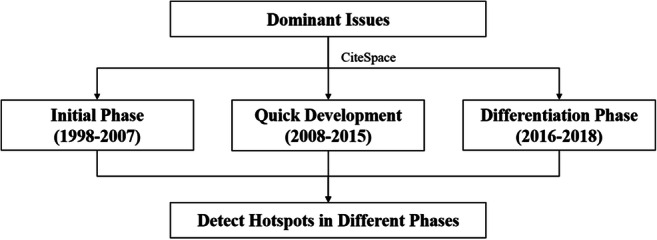
Analysis procedure of dominant issues
CiteSpace was used for word frequency and co-word analysis. The basic principle of co-word analysis is to count a group of words appearing at the same time in a document and measure the close relationship between them by the number of co-occurrences. The top 50 levels of most cited or occurred items from each slice (1998 to 2007; 2008 to 2015; 2016 to 2018) per year were selected. After merging the similar words (singular or plural form), the final keyword knowledge maps were generated as follows.
Initial phase (1998–2007)
In the early stage (Fig. 11), “green building” and “sustainability” were the main two clusters. Economics and “environmental assessment method” both had high betweenness centrality of 0.34 which were identified as pivotal points. Purple rings denote pivotal points in the network. The relationships in GB were simple at the initial stage of development.
Fig. 11.
Co-word analysis from 1998–2007
Sustainable construction is further enabled with tools that can evaluate the entire life cycle, site preparation and management, materials and their reusability, and the reduction of resource and energy consumption. Environmental building assessment methods were incorporated to achieve sustainable development, especially at the initial project appraisal stage (Ding 2008). Green Building Challenge (GBC) is an exceptional international research, development, and dissemination effort for developing building environmental performance assessments, primarily to help researchers and practitioners in dealing with difficult obstacles in assessing performance (Todd et al. 2001).
Quick development (2008–2015)
In the rapid growing stage (Fig. 12), pivot nodes and cluster centers were more complicated. Besides “green building” and “sustainability,” “energy efficiency” was the third hotspot word. The emergence of new vocabulary in the keyword network indicated that the research had made progress during 2008–2015. Energy performance, energy consumption, natural ventilation, thermal comfort, renewable energy, and embodied energy were all energy related. Energy becomes the most attractive field in achieving sustainability and green building. Other aspects such as “life cycle assessment,” “LEED,” and “thermal comfort” became attractive to researchers.
Fig. 12.
Co-word analysis from 2008–2015
The life cycle assessment (LCA) is a popular technique for the analysis of the technical side of GBs. LCA was developed from environmental assessment and economic analysis which could be a useful method to evaluate building energy efficiency from production and use to end-use (Chwieduk 2003). Much attention has been paid to LCA because people began to focus more on the actual performance of the GBs. Essentially, LCA simplifies buildings into systems, monitoring, and calculating mass flow and energy consumption over different stages in their life cycle.
Leadership in Energy and Environmental Design (LEED) was founded by the USGBC and began in the early twenty-first century (Doan et al. 2017). LEED is a not-for-profit project based on consumer demand and consensus that offers an impartial GB certification. LEED is the preferred building rating tool globally, with its shares growing rapidly. Meanwhile, UK’s Building Research Establishment Assessment Method (BREEAM) and Japan’s Comprehensive Assessment System for Building Environmental Efficiency (CASBEE) have been in use since the beginning of the twenty-first century, while New Zealand’s Green Star is still in its earlier stages. GBs around the world are made to suit regional climate concerns and need.
In practice, not all certified green buildings are necessarily performing well. Newsham et al. (2009) gathered energy-use information from 100 LEED-certified non-residential buildings. Results indicated that 28–35% of LEED structures actually consumed higher amounts of energy than the non-LEED structures. There was little connection in its actual energy consumption to its certification grade, meaning that further improvements are required for establishing a comprehensive GB rating metric to ensure consistent performance standards.
Thermal comfort was related to many aspects, such as materials, design scheme, monitoring system, and human behaviors. Materials have been a focus area for improving thermal comfort and reducing energy consumption. Wall (Schossig et al. 2005), floor (Ansuini et al. 2011), ceiling (Hu et al. 2018), window, and shading structures (Shen and Li 2016) were building envelopes which had been paid attention to over the years. Windows were important envelopes to improve thermal comfort. For existing and new buildings, rational use of windows and shading structures can enhance the ambient conditions of buildings (Mcleod et al. 2013). It was found that redesigning windows could reduce the air temperature by 2.5% (Elshafei et al. 2017), thus improving thermal comfort through passive features and reducing the use of active air conditioners (Perez-Fargallo et al. 2018). The monitoring of air conditioners’ performance could also prevent overheating of buildings (Ruellan and Park 2016).
Differentiation phase (2016–2018)
In the years from 2016 to 2018 (Fig. 13), “green building,” ”sustainability,” and “energy efficiency” were still the top three hotspots in GB research.
Fig. 13.
Co-word analysis from 2016–2018
Zero-energy building (ZEB) became a substitute for low energy building in this stage. ZEB was first introduced in 2000 (Cao et al. 2016) and was believed to be the solution to the potential ramifications of future energy consumption by buildings (Liu et al. 2019). The EU has been using ZEB standards in all of its new building development projects to date (Communuties 2002). The USA passed the Energy Independence and Security Act of 2007, aiming for zero net energy consumption of 1 out of every 2 commercial buildings that are yet to be built by 2040 and for all by 2050 (Sartori et al. 2012). Energy consumption became the most important factor in new building construction.
Renewable energy was a key element of sustainable development for mankind and nature (Zhang et al. 2013). Using renewable energy was an important feature of ZEBs (Cao et al. 2016; Pulselli et al. 2007). Renewable energy, in the form of solar, wind, geothermal, clean bioenergy, and marine can be used in GBs. Solar energy has been widely used in recent years while wind energy is used locally because of its randomness and unpredictable features. Geothermal energy is mainly utilized by ground source heat pump (GSHP), which has been lauded as a powerful energy system for buildings (Cao et al. 2016). Bioenergy has gained much popularity as an alternative source of energy around the globe because it is more stable and accessible than other forms of energy (Zhang et al. 2015). There is relatively little use of marine energy, yet this may potentially change depending on future technological developments (Ellabban et al. 2014).
Residential buildings receive more attention because people spend 90% of their time inside. Contrary to popular belief, the concentration of contaminants found indoors is more than the concentration outside, sometimes up to 10 times or even 100 times more (agency). The renovation of existing buildings can save energy, upgrade thermal comfort, and improve people’s living conditions.
Energy is a substantial and widely recognized cost of building operations that can be reduced through energy-saving and green building design. Nevertheless, a consensus has been reached by academics and those in building-related fields that GBs are significantly more energy efficient than traditional buildings if designed, constructed, and operated with meticulousness (Wuni et al. 2019b). The drive to reduce energy consumption from buildings has acted as a catalyst in developing new technologies.
Patent analysis
Compared with the article analysis, patents can better reflect the practical technological application to a certain extent. We extracted the information of green building energy-related patent records between 1998 and 2018 from the Derwent Innovations Index database. The development of a technique follows a path: precursor–invention–development–maturity. This is commonly known as an S-type growth (Mao et al. 2018). Two thousand six hundred thirty-eight patents were found which were classified into “Derwent Manual Code,” which is the most distinct feature just like “keywords” in the Derwent Innovations Index. Manual codes refer to specific inventions, technological innovations, and unique codes for their applications. According to the top 20 Derwent Manual Code which accounted for more than 80% of the total patents, we classified the hotspots patents into three fields for further S-curve analysis, which are “structure,” “material,” and “energy systems” (Table 3).
Table 3.
Top 20 keywords in classified patents
| Class | Derwent Manual Code | Keyword | TP |
|---|---|---|---|
| Structure | Q43-A01 | Walls | 288 |
| A12-R07 | walls, wall coverings and ceilings | 160 | |
| Q45-A01 | roof covering | 111 | |
| Q43-402 | roofs | 70 | |
| Q44-A10 | sheets, panels | 69 | |
| A12-R01 | building, civil engineering [general] | 167 | |
| Q44-A | Structural components | 65 | |
| Q43-A | Types of building structures | 60 | |
| Q43-A04 | floors | 59 | |
| Material | A12-R06 | thermal and/or acoustic insulation; honeycomb structures | 191 |
| A12-R01A | concrete, cement, gypsum, mortar compositions and boards | 79 | |
| L02-A03 | Refractories, ceramics, cement manufacture-shaping, drying | 57 | |
| Energy system | X15-A05 | large scale solar power generation | 162 |
| Q43-A99 | general building insulation | 99 | |
| X15-A02C | solar / photovoltaic panel details | 88 | |
| Q74-A02A | Fluid heating system | 69 | |
| Q74-A02B | Air conditioning systems | 68 | |
| X15-A02X | Other solar/photovoltaic panels/cells details | 68 | |
| Q74-A02E | Ventilation systems | 59 | |
| X15-A01A | Heat collecting panels | 56 |
Structure
Sustainable structural design (SSD) has gained a lot of research attention from 2006 to 2016 (Pongiglione and Calderini 2016). The S-curve of structure* (Fig. 14) has just entered the later period of the growth stage, accounting for 50% of the total saturation in 2018. Due to its effectiveness and impact, SSD has overtime gained recognition and is now considered by experts to be a prominent tool in attaining sustainability goals (Pongiglione and Calderini 2016).
Fig. 14.
The S-curves of different Structure types from patents
Passive design is important in energy saving which is achieved by appropriately orientating buildings and carefully designing the building envelope. Building envelopes, which are key parts of the energy exchange between the building and the external environment, include walls, roofs, windows, and floors. The EU increased the efficiency of its heat-regulating systems by revamping building envelopes as a primary energy-saving task during 2006 to 2016 (Cao et al. 2016).
We analyzed the building envelope separately. According to the S-curve (Fig. 14), the number of patents related to GB envelops are in the growth stage. At present, building envelops such as walls, roofs, windows, and even doors have not reached 50% of the saturated quantity. Walls and roofs are two of the most important building envelops. The patent contents of walls mainly include wall materials and manufacturing methods, modular wall components, and wall coatings while technologies about roofs mainly focus on roof materials, the combination of roof and solar energy, and roof structures. Green roofs are relatively new sustainable construction systems because of its esthetic and environmental benefits (Wei et al. 2015).
Material
The material resources used in the building industry consume massive quantities of natural and energy resources consumptions (Wang et al. 2018). The energy-saving building material is economical and environmentally friendly, has low coefficient heat conductivity, fast curing speed, high production efficacy, wide raw material source and flame, and wear resistance properties (Zhang et al. 2014). Honeycomb structures were used for insulating sustainable buildings. They are lightweight and conserve energy making them eco-friendly and ideal for construction (Miao et al. 2011).
According to the S-curve (Fig. 15), it can be seen that the number of patents on the GB “material” is in the growth stage. It is expected that the number of patents will reach 50% of the total saturation in 2022.
Fig. 15.
The S-curves of a different material from patents
Building material popularly used comprised of cement, concrete, gypsum, mortar compositions, and boards. Cement is widely used in building material because of its easy availability, strong hardness, excellent waterproof and fireproof performance, and low cost. The S-curve of cement is in the later period of the growth stage, which will reach 90% of the total saturation in 2028. Composite materials like Bamcrete (bamboo-concrete composite) and natural local materials like Rammed Earth had better thermal performance compared with energy-intensive materials like bricks and cement (Kandya and Mohan 2018). Novel bricks synthesized from fly ash and coal gangue have better advantages of energy saving in brick production phases compared with that of conventional types of bricks (Zhang et al. 2014). For other materials like gypsum or mortar, the numbers of patents are not enough for S-curve analysis. New-type green building materials offer an alternative way to realize energy-saving for sustainable constructions.
Energy system
The energy system mainly included a heating system and ventilation system according to the patent analysis. So, we analyzed solar power systems and air conditioning systems separately. Heat* included heat collecting panels and a fluid heating system.
The results indicated that heat*-, solar-, and ventilation-related technologies were in the growth stage which would reach 50% of the total saturation in 2022 (Fig. 16). Photovoltaic technology is of great importance in solar energy application (Khan and Arsalan 2016).
Fig. 16.
The S-curves of energy systems from patents
On the contrary, air conditioning technologies had entered into the mature stage after a decade of development. It is worth mentioning that the design of the fresh air system of buildings after the COVID-19 outbreak is much more important. With people spending the majority of their time inside (Liu et al. 2019), volatile organic compounds, formaldehyde, and carbon dioxide received the most attention worldwide (Wei et al. 2015). Due to health problems like sick building syndrome, and more recently since the COVID-19 outbreak, the supply of fresh air can drastically ameliorate indoor air quality (IAQ) (Liu et al. 2019). Regulating emissions from materials, enhanced ventilation, and monitoring air indoors are the main methods used in GBs for maintaining IAQ (Wei et al. 2015). Air circulation frequency and improved air filtration can reduce the risk of spreading certain diseases, while controlling the airflow between rooms can also prevent cross-infections. Poor indoor air quality and ventilation provide ideal conditions for the breeding and spreading of viruses by air (Chen et al. 2019). A diverse range of air filters coupled with a fresh air supply system should be studied. A crucial step forward is to create a cost-effective, energy-efficient, intelligent fresh air supply system (Liu et al. 2017) to monitor, filter outdoor PM2.5 (Chen et al. 2017), and saving building energy (Liu and Liu 2005). Earth-air heat exchanger system (EAHE) is a novel technology that supplies fresh air using underground soil heat (Chen et al. 2019).
Conclusion
Summary
A total of 5246 journal articles in English from the SCI and SSCI databases published in 1998–2018 were reviewed and analyzed. The study revealed that the literature on green buildings has grown rapidly over the past 20 years. The findings and results are summarized:
Data analysis revealed that GB research is distributed across various subject categories. Energy and Buildings, Building and Environment, Journal of Cleaner Production, and Sustainability were the top journals to publish papers on green buildings.
Global distribution was done to see the green building study worldwide, showing that the USA, China, and the UK ranked the top three countries, accounting for 14.98%, 13.29%, and 8.27% of all the publications respectively. Australia and China had the closest relationship on green building research cooperation worldwide.
Further analysis was made on countries’ characteristics, dominant issues through keyword co-occurrence, green building technology by patent analysis, and S-curve prediction. Global trends of the top 5 countries showed different characteristics. China had a steady and consistent growth in publications each year while the USA, the UK, and Italy were on a decline from 2016. The big data method was used to see the city performance in China, finding that the total publications had a high correlation with the city’s GDP and Baidu Search Index. Policies were regarded as the stimulation for green building development, either in China or the UK. Also, barriers and contradictions such as cost, occupants’ comfort, and energy consumption were discussed about the developed and developing countries.
Cluster and content analysis via CiteSpace identified popular and trending research topics at different stages of development; the top three hotspots were green buildings, sustainability, and energy efficiency throughout the whole research period. Energy efficiency has shifted from low to zero energy buildings or even beyond it in recent years. Energy efficiency was the most important drive to achieve green buildings while LCA and LEED were the two potential ways to evaluate building performance. Thermal comfort and natural ventilation of residential buildings became a topic of interest to the public.
Then, we combined the keywords with “energy” to make further patent analysis in Derwent Innovations Index. “Structure,” “material,” and “energy systems” were three of the most important types of green building technologies. According to S-curve analysis, most of the technologies of energy-saving buildings were on the fast-growing trend, and even though there were conflicts and doubts in different countries on GB adoption, it is still a promising field.
Future directions
An establishment of professional institutes or a series of policies and regulations on green building promulgated by government departments will promote research development (as described in the “Further Analysis on China, the USA, and the UK” section). Thus, a policy enacted by a formal department is of great importance in this particular field.
Passive design is important in energy saving which is ensured by strategically positioning buildings and precisely engineering the building envelope, i.e., roof, walls, windows, and floors. A quality, the passive-design house is crucial to achieving sustained thermal comfort, low-carbon footprint, and a reduced gas bill. The new insulation material is a promising field for reducing building heat loss and energy consumed. Healthy residential buildings have become a focus of future development due to people’s pursuit of a healthy life. A fresh air supply system is important for better indoor air quality and reduces the risk of transmission of several diseases. A 2020 study showed the COVID-19 virus remains viable for only 4 hours on copper compared to 24 h on cardboard. So, antiviral materials will be further studied for healthy buildings (Fezi 2020).
With the quick development of big data method and intelligent algorithms, artificial intelligence (AI) green buildings will be a trend. The core purpose of AI buildings is to achieve optimal operating conditions through the accurate analysis of data, collected by sensors built into green buildings. “Smart buildings” and “Connected Buildings” of the future, fitted with meters and sensors, can collect and share massive amounts of information regarding energy use, water use, indoor air quality, etc. Analyzing this data can determine relationships and patterns, and optimize the operation of buildings to save energy without compromising the quality of the indoor environment (Lazarova-Molnar and Mohamed 2019).
The major components of green buildings, such as building envelope, windows, and skylines, should be adjustable and versatile in order to get full use of AI. A digital control system can give self-awareness to buildings, adjusting room temperature, indoor air quality, and air cooling/heating conditions to control power consumption, and make it sustainable (Mehmood et al. 2019).
Concerns do exist, for example, occupant privacy, data security, robustness of design, and modeling of the AI building (Maasoumy and Sangiovanni-Vincentelli 2016). However, with increased data sources and highly adaptable infrastructure, AI green buildings are the future.
This examination of research conducted on green buildings between the years 1998 and 2018, through bibliometric analysis combined with other useful tools, offers a quantitative representation of studies and data conducted in the past and present, bridging historical gaps and forecasting the future of green buildings—providing valuable insight for academicians, researchers, and policy-makers alike.
Supplementary Information
(DOCX 176 kb)
Availability of data and materials
The datasets generated and analyzed throughout the current study are available in the Web of Science Core Collection.
Appendix
(From Web of Science Core Collection)
Topic: (“bioclimatic architect*” or “bioclimatic build*” or “bioclimatic construct*” or “bioclimatic hous*” or “eco-architect*” or “eco-build*” or “eco-home*” or “eco-hous*” or “eco-friendly build*” or “ecological architect*” or “ecological build*” or “ecological hous*” or “energy efficient architect*” or “energy efficient build*” or “energy efficient construct*” or “energy efficient home*” or “energy efficient hous*” or “energy efficient struct*” or “energy saving architect*” or “energy saving build*” or “energy saving construct*” or “energy saving home*” or “energy saving hous*” or “energy saving struct*” or “green architect*” or “green build*” or “green construct*” or “green home*” or “low carbon architect*” or “low carbon build*” or “low carbon construct*” or “low carbon home*” or “low carbon hous*” or “low energy architect*” or “low energy build*” or “low energy construct*” or “low energy home*” or “low energy hous*” or “sustainable architect*” or “sustainable build*” or “sustainable construct*” or “sustainable home*” or “sustainable hous*” or “zero energy build*” or “zero energy home*” or “zero energy hous*” or “net zero energy build*” or “net zero energy home*” or “net zero energy hous*” or “zero-carbon build*” or “zero-carbon home*” or “zero-carbon hous*” or “carbon neutral build*” or “carbon neutral construct*” or “carbon neutral hous*” or “high performance architect*” or “high performance build*” or “high performance construct*” or “high performance home*” or “high performance hous*”)
Time span: 1998-2018。 Index: SCI-EXPANDED, SSCI。
Author contributions
Ying Li conceived the frame of the paper and wrote the manuscript. Yanyu Rong made the data figures and participated in writing the manuscript. Umme Marium Ahmad helped with revising the language. Xiaotong Wang consulted related literature for the manuscript. Jian Zuo contributed significantly to provide the keywords list. Guozhu Mao helped with constructive suggestions.
Funding
This study was supported by The National Natural Science Foundation of China (No.51808385).
Declarations
Ethics approval and consent to participate
This manuscript is ethical.
Consent for publication
Not applicable.
Competing interest
The authors declare no competing interest.
Footnotes
Publisher’s Note
Springer Nature remains neutral with regard to jurisdictional claims in published maps and institutional affiliations.
References
- Agency USEP Indoor Air Quality https://www.epa.gov/indoor-air-quality-iaq.
- Ansuini R, Larghetti R, Giretti A, Lemma M. Radiant floors integrated with PCM for indoor temperature control. Energy Build. 2011;43:3019–3026. doi: 10.1016/j.enbuild.2011.07.018. [DOI] [Google Scholar]
- Bengisu M, Nekhili R. Forecasting emerging technologies with the aid of science and technology databases. Technol Forecast Soc Chang. 2006;73:835–844. doi: 10.1016/j.techfore.2005.09.001. [DOI] [Google Scholar]
- Bozeman B, Fay D, Slade CP. Research collaboration in universities and academic entrepreneurship: the-state-of-the-art. J Technol Transf. 2013;38:1–67. doi: 10.1007/s10961-012-9281-8. [DOI] [Google Scholar]
- Building AG Importance of Green Building. https://www.greenbuilt.org/about/importance-of-green-building
- Cao XD, Dai XL, Liu JJ. Building energy-consumption status worldwide and the state-of-the-art technologies for zero-energy buildings during the past decade. Energy Build. 2016;128:198–213. doi: 10.1016/j.enbuild.2016.06.089. [DOI] [Google Scholar]
- Chan APC, Darko A, Olanipekun AO, Ameyaw EE. Critical barriers to green building technologies adoption in developing countries: the case of Ghana. J Clean Prod. 2018;172:1067–1079. doi: 10.1016/j.jclepro.2017.10.235. [DOI] [Google Scholar]
- Chen CC, Lo TH, Tsay YS, Lee CY, Liu KS. Application of a novel formaldehyde sensor with MEMS (micro electro mechanical systems) in indoor air quality test and improvement in medical spaces. Appl Ecol Environ Res. 2017;15:81–89. doi: 10.15666/aeer/1502_081089. [DOI] [Google Scholar]
- Chen CM. CiteSpace II: detecting and visualizing emerging trends and transient patterns in scientific literature. J Am Soc Inf Sci Technol. 2006;57:359–377. doi: 10.1002/asi.20317. [DOI] [Google Scholar]
- Chen X, Lu WS, Xue F, Xu JY. A cost-benefit analysis of green buildings with respect to construction waste minimization using big data in Hong Kong. J Green Build. 2018;13:61–76. doi: 10.3992/1943-4618.13.4.61. [DOI] [Google Scholar]
- Chen XY, Niu RP, Lv LN, Kuang DQ, LOP (2019) Discussion on existing problems of fresh air system. In: 4th International Conference on Advances in Energy Resources and Environment Engineering, vol 237. IOP Conference Series-Earth and Environmental Science. Iop Publishing Ltd, Bristol. doi:10.1088/1755-1315/237/4/042030
- Chwieduk D. Towards sustainable-energy buildings. Appl Energy. 2003;76:211–217. doi: 10.1016/s0306-2619(03)00059-x. [DOI] [Google Scholar]
- Communuties CotE (2002) Directive of the European parliament and the council.
- Daim TU, Rueda G, Martin H, Gerdsri P. Forecasting emerging technologies: use of bibliometrics and patent analysis. Technol Forecast Soc Chang. 2006;73:981–1012. doi: 10.1016/j.techfore.2006.04.004. [DOI] [Google Scholar]
- Ding GKC. Sustainable construction - the role of environmental assessment tools. J Environ Manag. 2008;86:451–464. doi: 10.1016/j.jenvman.2006.12.025. [DOI] [PubMed] [Google Scholar]
- Doan DT, Ghaffarianhoseini A, Naismith N, Zhang TR, Ghaffarianhoseini A, Tookey J. A critical comparison of green building rating systems. Build Environ. 2017;123:243–260. doi: 10.1016/j.buildenv.2017.07.007. [DOI] [Google Scholar]
- Du HB, Li BL, Brown MA, Mao GZ, Rameezdeen R, Chen H. Expanding and shifting trends in carbon market research: a quantitative bibliometric study. J Clean Prod. 2015;103:104–111. doi: 10.1016/j.jclepro.2014.05.094. [DOI] [Google Scholar]
- Du HB, Liu DY, Lu ZM, Crittenden J, Mao GZ, Wang S, Zou HY. Research development on sustainable urban infrastructure from 1991 to 2017: a bibliometric analysis to inform future innovations. Earth Future. 2019;7:718–733. doi: 10.1029/2018ef001117. [DOI] [Google Scholar]
- Ellabban O, Abu-Rub H, Blaabjerg F. Renewable energy resources: current status, future prospects and their enabling technology. Renew Sust Energ Rev. 2014;39:748–764. doi: 10.1016/j.rser.2014.07.113. [DOI] [Google Scholar]
- Elshafei G, Negm A, Bady M, Suzuki M, Ibrahim MG. Numerical and experimental investigations of the impacts of window parameters on indoor natural ventilation in a residential building. Energy Build. 2017;141:321–332. doi: 10.1016/j.enbuild.2017.02.055. [DOI] [Google Scholar]
- Ernst H. The use of patent data for technological forecasting: the diffusion of CNC-technology in the machine tool industry. Small Bus Econ. 1997;9:361–381. doi: 10.1023/A:1007921808138. [DOI] [Google Scholar]
- Fezi BA. Health engaged architecture in the context of COVID-19. J Green Build. 2020;15:185–212. doi: 10.3992/1943-4618.15.2.185. [DOI] [Google Scholar]
- Guozhu, et al. Bibliometric analysis of insights into soil remediation. J Soils Sediments. 2018;18:2520–2534. doi: 10.1007/s11368-018-1932-4. [DOI] [Google Scholar]
- Ho S-Y. Bibliometric analysis of biosorption technology in water treatment research from 1991 to 2004. Int J Environ Pollut. 2008;34:1–13. doi: 10.1504/ijep.2008.020778. [DOI] [Google Scholar]
- Hong WX, Jiang ZY, Yang Z, (2017) Iop (2017) Analysis on the restriction factors of the green building scale promotion based on DEMATEL. In: 2nd International Conference on Advances in Energy Resources and Environment Engineering, vol 59. IOP Conference Series-Earth and Environmental Science. Iop Publishing Ltd, Bristol. doi:10.1088/1755-1315/59/1/012064
- Hu J, Kawaguchi KI, Ma JJB. Retractable membrane ceiling on indoor thermal environment of residential buildings. Build Environ. 2018;146:289–298. doi: 10.1016/j.buildenv.2018.09.035. [DOI] [Google Scholar]
- Huang N, Bai LB, Wang HL, Du Q, Shao L, Li JT. Social network analysis of factors influencing green building development in China. Int J Environ Res Public Health. 2018;15:16. doi: 10.3390/ijerph15122684. [DOI] [PMC free article] [PubMed] [Google Scholar]
- Huibin D, Guozhu M, Xi L, Jian Z, Linyuan W. Way forward for alternative energy research: a bibliometric analysis during 1994-2013. Sustain Energy Rev. 2015;48:276–286. doi: 10.1016/j.rser.2015.03.094. [DOI] [Google Scholar]
- Jalaei F, Jrade A. Integrating building information modeling (BIM) and LEED system at the conceptual design stage of sustainable buildings. Sustain Cities Soc. 2015;18(95-10718):95–107. doi: 10.1016/j.scs.2015.06.007. [DOI] [Google Scholar]
- Kandya A, Mohan M. Mitigating the urban heat island effect through building envelope modifications. Energy Build. 2018;164:266–277. doi: 10.1016/j.enbuild.2018.01.014. [DOI] [Google Scholar]
- Khan J, Arsalan MH. Solar power technologies for sustainable electricity generation - a review. Renew Sust Energ Rev. 2016;55:414–425. doi: 10.1016/j.rser.2015.10.135. [DOI] [Google Scholar]
- Khoshbakht, et al. Are green buildings more satisfactory? A review of global evidence. Habitat Int. 2018;74:57–65. doi: 10.1016/j.habitatint.2018.02.005. [DOI] [Google Scholar]
- Lazarova-Molnar S, Mohamed N. Collaborative data analytics for smart buildings: opportunities and models. Clust Comput. 2019;22:1065–1077. doi: 10.1007/s10586-017-1362-x. [DOI] [Google Scholar]
- Li X, Wu P, Shen GQ, Wang X, Teng Y. Mapping the knowledge domains of building information modeling (BIM): a bibliometric approach. Autom Constr. 2017;84:195–206. doi: 10.1016/j.autcon.2017.09.011. [DOI] [Google Scholar]
- Liu CY, Wang JC. Forecasting the development of the biped robot walking technique in Japan through S-curve model analysis. Scientometrics. 2010;82:21–36. doi: 10.1007/s11192-009-0055-5. [DOI] [Google Scholar]
- Liu GL, et al. A review of air filtration technologies for sustainable and healthy building ventilation. Sustain Cities Soc. 2017;32:375–396. doi: 10.1016/j.scs.2017.04.011. [DOI] [Google Scholar]
- Liu J, Liu GQ. Some indoor air quality problems and measures to control them in China Indoor. Built Environ. 2005;14:75–81. doi: 10.1177/1420326x05050362. [DOI] [Google Scholar]
- Liu ZB, Li WJ, Chen YZ, Luo YQ, Zhang L. Review of energy conservation technologies for fresh air supply in zero energy buildings. Appl Therm Eng. 2019;148:544–556. doi: 10.1016/j.applthermaleng.2018.11.085. [DOI] [Google Scholar]
- Liu ZJ, Pyplacz P, Ermakova M, Konev P. Sustainable construction as a competitive advantage. Sustainability. 2020;12:13. doi: 10.3390/su12155946. [DOI] [Google Scholar]
- Maasoumy M, Sangiovanni-Vincentelli A. Smart connected buildings design automation: foundations and trends found trends. Electron Des Autom. 2016;10:1–3. doi: 10.1561/1000000043. [DOI] [Google Scholar]
- Mao G, Zou H, Chen G, Du H, Zuo J. Past, current and future of biomass energy research: a bibliometric analysis. Sustain Energy Rev. 2015;52:1823–1833. doi: 10.1016/j.rser.2015.07.141. [DOI] [Google Scholar]
- Mao GZ, Shi TT, Zhang S, Crittenden J, Guo SY, Du HB. Bibliometric analysis of insights into soil remediation. J Soils Sediments. 2018;18:2520–2534. doi: 10.1007/s11368-018-1932-4. [DOI] [Google Scholar]
- Marinakis V. Big data for energy management and energy-efficient buildings. Energies. 2020;13:18. doi: 10.3390/en13071555. [DOI] [Google Scholar]
- McArthur JJ, Powell C. Health and wellness in commercial buildings: systematic review of sustainable building rating systems and alignment with contemporary research. Build Environ. 2020;171:18. doi: 10.1016/j.buildenv.2019.106635. [DOI] [Google Scholar]
- Mcleod RS, Hopfe CJ, Kwan A. An investigation into future performance and overheating risks in Passivhaus dwellings. Build Environ. 2013;70:189–209. doi: 10.1016/j.buildenv.2013.08.024. [DOI] [Google Scholar]
- Mclinden D. Concept maps as network data: analysis of a concept map using the methods of social network analysis. Eval Program Plann. 2013;36:40–48. doi: 10.1016/j.evalprogplan.2012.05.001. [DOI] [PubMed] [Google Scholar]
- Mehmood MU, Chun D, Zeeshan, Han H, Jeon G, Chen K. A review of the applications of artificial intelligence and big data to buildings for energy-efficiency and a comfortable indoor living environment. Energy Build. 2019;202:13. doi: 10.1016/j.enbuild.2019.109383. [DOI] [Google Scholar]
- Miao XL, Yao Y, Wang Y, Chu YP. Experimental research on the sound insulation property of lightweight composite paper honeycomb core wallboard. In: Jiang ZY, Li SQ, Zeng JM, Liao XP, Yang DG, editors. Manufacturing Process Technology, Pts 1-5. Stafa-Zurich: Advanced Materials Research. Trans Tech Publications Ltd; 2011. pp. 1334–1339. [Google Scholar]
- Newsham GR, Mancini S, Energy BJ. Do LEED-certified buildings save energy? Yes, but…. Energy Build. 2009;41:897–905. doi: 10.1016/j.enbuild.2009.03.014. [DOI] [Google Scholar]
- Nguyen HT, Skitmore M, Gray M, Zhang X, Olanipekun AO. Will green building development take off? An exploratory study of barriers to green building in Vietnam. Resour Conserv Recycl. 2017;127:8–20. doi: 10.1016/j.resconrec.2017.08.012. [DOI] [Google Scholar]
- Paul WL, Taylor PA. A comparison of occupant comfort and satisfaction between a green building and a conventional building. Build Environ. 2008;43:1858–1870. doi: 10.1016/j.buildenv.2007.11.006. [DOI] [Google Scholar]
- Perez-Fargallo A, Rubio-Bellido C, Pulido-Arcas JA, Gallego-Maya I, Guevara-Garcia FJ. Influence of adaptive comfort models on energy improvement for housing in cold areas. Sustainability. 2018;10:15. doi: 10.3390/su10030859. [DOI] [Google Scholar]
- Pongiglione M, Calderini C. Sustainable structural design: comprehensive literature review. J Struct Eng. 2016;142:15. doi: 10.1061/(asce)st.1943-541x.0001621. [DOI] [Google Scholar]
- Pouris A, Pouris A. Scientometrics of a pandemic: HIV/AIDS research in South Africa and the World. Scientometrics. 2011;86:541–552. doi: 10.1007/s11192-010-0277-6. [DOI] [Google Scholar]
- Pulselli RM, Simoncini E, Pulselli FM, Bastianoni S. Emergy analysis of building manufacturing, maintenance and use: Em-building indices to evaluate housing sustainability. Energy Build. 2007;39:620–628. doi: 10.1016/j.enbuild.2006.10.004. [DOI] [Google Scholar]
- Ruellan M, Park H, Bennacer R. Residential building energy demand and thermal comfort: thermal dynamics of electrical appliances and their impact. Energy Build. 2016;130:46–54. doi: 10.1016/j.enbuild.2016.07.029. [DOI] [Google Scholar]
- Sartori I, Napolitano A, Voss K. Net zero energy buildings: a consistent definition framework. Energy Build. 2012;48:220–232. doi: 10.1016/j.enbuild.2012.01.032. [DOI] [Google Scholar]
- Schossig P, Henning HM, Gschwander S, Haussmann T (2005) Micro-encapsulated phase-change materials integrated into construction materials. Solar Energy Mater Solar Cells 89:297-306
- Shen C, Li XT. Solar heat gain reduction of double glazing window with cooling pipes embedded in venetian blinds by utilizing natural cooling. Energy Build. 2016;112:173–183. doi: 10.1016/j.enbuild.2015.11.073. [DOI] [Google Scholar]
- Shen L, Yan H, Fan H, Wu Y, Zhang Y. An integrated system of text mining technique and case-based reasoning (TM-CBR) for supporting green building design. Build Environ. 2017;124:388–401. doi: 10.1016/j.buildenv.2017.08.026. [DOI] [Google Scholar]
- Todd JA, Crawley D, Geissler S, Lindsey G. Comparative assessment of environmental performance tools and the role of the Green Building Challenge. Build Res Inf. 2001;29:324–335. doi: 10.1080/09613210110064268. [DOI] [Google Scholar]
- Wang H, Chiang PC, Cai Y, Li C, Wang X, Chen TL, Wei S, Huang Q. Application of wall and insulation materials on green building: a review. Sustainability. 2018;10:21. doi: 10.3390/su10093331. [DOI] [Google Scholar]
- Wang J, Liu Y, Ren J, Cho S, (2017) Iop (2017) A brief comparison of existing regional green building design standards in China. In: 2nd International Conference on Advances in Energy Resources and Environment Engineering, vol 59. IOP Conference Series-Earth and Environmental Science. Iop Publishing Ltd, Bristol. doi:10.1088/1755-1315/59/1/012013
- Wei WJ, Ramalho O, Mandin C. Indoor air quality requirements in green building certifications. Build Environ. 2015;92:10–19. doi: 10.1016/j.buildenv.2015.03.035. [DOI] [Google Scholar]
- Wuni IY, Shen GQP, Osei-Kyei R. Scientometric review of global research trends on green buildings in construction journals from 1992 to 2018. Energy Build. 2019;190:69–85. doi: 10.1016/j.enbuild.2019.02.010. [DOI] [Google Scholar]
- Wuni IY, Shen GQP, Osei RO (2019b) Scientometric review of global research trends on green buildings in construction journals from 1992 to 2018 Energy Build 190:69-85 doi:10.1016/j.enbuild.2019.02.010
- Yang XD, Zhang JY, Zhao XB. Factors affecting green residential building development: social network analysis. Sustainability. 2018;10:21. doi: 10.3390/su10051389. [DOI] [Google Scholar]
- Ye L, Cheng Z, Wang Q, Lin H, Lin C, Liu B. Developments of Green Building Standards in China. Renew Energy. 2015;73:115–122. doi: 10.1016/j.renene.2014.05.014. [DOI] [Google Scholar]
- Ye Q, Li T, Law R. A coauthorship network analysis of tourism and hospitality research collaboration. J Hosp Tour Res. 2013;37:51–76. doi: 10.1177/1096348011425500. [DOI] [Google Scholar]
- Yoon B, Park Y. A text-mining-based patent network: analytical tool for high-technology trend. J High Technol Manag Res. 2004;15:37–50. doi: 10.1016/j.hitech.2003.09.003. [DOI] [Google Scholar]
- Yuan XL, Wang XJ, Zuo J. Renewable energy in buildings in China-a review. Renew Sust Energ Rev. 2013;24:1–8. doi: 10.1016/j.rser.2013.03.022. [DOI] [Google Scholar]
- Zhang HT, Hu D, Wang RS, Zhang Y. Urban energy saving and carbon reduction potential of new-types of building materials by recycling coal mining wastes. Environ Eng Manag J. 2014;13:135–144. doi: 10.30638/eemj.2014.017. [DOI] [Google Scholar]
- Zhang HZ, Li H, Huang BR, Destech Publicat I (2015) Development of biogas industry in Beijing. 2015 4th International Conference on Energy and Environmental Protection. Destech Publications, Inc, Lancaster
- Zhang SF, Andrews-Speed P, Zhao XL, He YX. Interactions between renewable energy policy and renewable energy industrial policy: a critical analysis of China’s policy approach to renewable energies. Energy Policy. 2013;62:342–353. doi: 10.1016/j.enpol.2013.07.063. [DOI] [Google Scholar]
- Zhang Y, Huang K, Yu YJ, Yang BB. Mapping of water footprint research: a bibliometric analysis during 2006-2015. J Clean Prod. 2017;149:70–79. doi: 10.1016/j.jclepro.2017.02.067. [DOI] [Google Scholar]
- Zhang Y, Kang J, Jin H. A review of Green Building Development in China from the perspective of energy saving. Energies. 2018;11:18. doi: 10.3390/en11020334. [DOI] [Google Scholar]
- Zhao XB, Zuo J, Wu GD, Huang C. A bibliometric review of green building research 2000-2016. Archit Sci Rev. 2019;62:74–88. doi: 10.1080/00038628.2018.1485548. [DOI] [Google Scholar]
- Zuo J, Zhao ZY. Green building research-current status and future agenda: a review. Renew Sust Energ Rev. 2014;30:271–281. doi: 10.1016/j.rser.2013.10.021. [DOI] [Google Scholar]
Associated Data
This section collects any data citations, data availability statements, or supplementary materials included in this article.
Supplementary Materials
(DOCX 176 kb)



